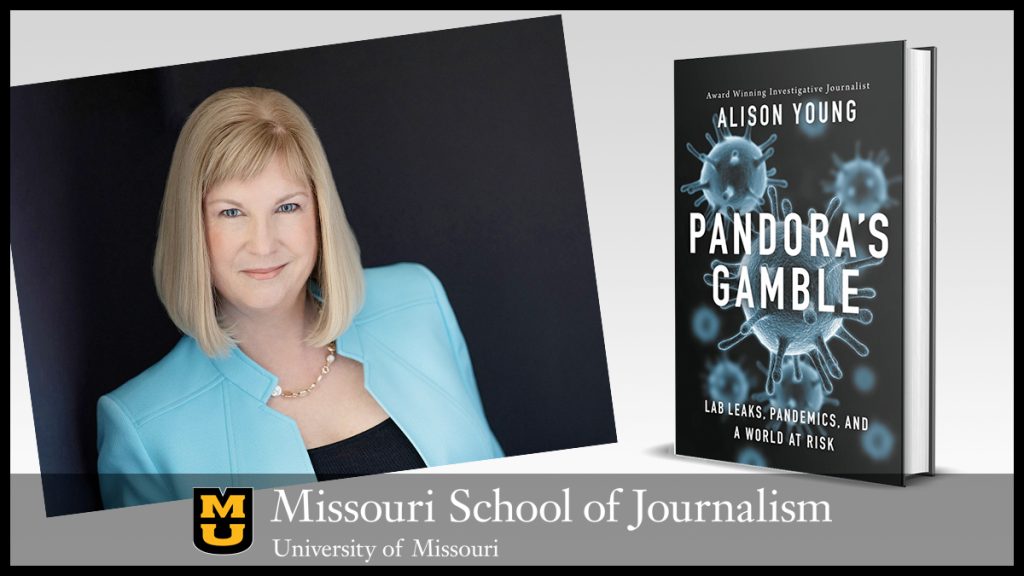Missouri School of Journalism Professor Alison Young releases ‘Pandora’s Gamble’

Young’s first book brings together her professional experience as an investigative journalist and her Missouri Method approach to teaching
COLUMBIA, Mo. (April 28, 2023) — Alison Young, the Curtis B. Hurley Chair in Public Affairs Reporting at the Missouri School of Journalism, has released a new book — her first — about the history and implications of safety lapses in scientific labs, as well as the potential role of such a lapse in the origins of the COVID-19 pandemic.
The book, “Pandora’s Gamble,” is the latest example of the rigorous investigative reporting that defined her decades-long career in roles at USA Today, Investigative Reporters and Editors and the Atlanta Journal Constitution before she took the helm of the School’s Washington Program. At the same time, it’s the product of research that embodies the School’s emphasis on science communication, impactful journalism and hands-on student experience.
“Alison is among the best investigative journalists in the country, and her work continues to be a huge inspiration for students, whether or not they are part of the Washington Program,” said David Kurpius, dean of the School of Journalism. “There is no substitute for an educator who can talk about a concept by saying ‘I’ve done that, and here’s how it went.’ That’s the core of the Missouri Method we abide by at the School.”
Similarly, it was Young’s unique pedigree as a journalist who has unearthed little-known stories of lab accidents all over the country that made “Pandora’s Gamble” the perfect project for her. Combined with the mandate of her position as the Hurley Chair, a position intended to support journalism’s role in important decision-making on public affairs issues, the notion of Young taking a deep dive into this subject matter seemed a foregone conclusion.
“I’ve been involved in investigating lab accidents for about 15 years,” Young said. “It’s sort of an obscure area of expertise when it comes to journalism — most journalists involved in science and health journalism aren’t writing about laboratory accidents. There was a need to have some reporting about the potential role of the lab accident hypothesis in the pandemic.”
My skills and the examples I bring into the classroom are current in real life. I’m sharing with my students what FOIA denials look like. I’m sharing the kinds of pushback and barriers there are to accessing information. All of this is about learning by doing.
Alison Young
The book also functions as a demonstration of the important role of journalism in science communication, a key priority of the School of Journalism. In taking a straightforward look at the “lab leak” hypothesis, Young sought to disentangle the topic from misinformation and non-scientific discourse, grounding her discussion in research into real-life incidents from around the world.
In doing so, Young seized the opportunity to include students in the process of research and data collection.
“A lot of this information is coming from using the public’s ability to force the release of information under state and federal open records laws,” Young said. “The students working with me on this project got wonderful, hands-on experience filing open records requests and following National Institutes of Health guidelines for information disclosure requests.”
Jessica Blake and Skylar Laird, both of whom graduated in 2022, helped Young track down leads and fill in background information as student interns. Laird said the work sometimes took her down lines of research that led deep into the past.
“There was a lot of trying to track down family members of people who had worked in labs in the 1920s and 30s,” Laird said. “Alison would see names in old documents and news stories, and I would go through obituaries to try and track down family members and descendants.”
Laird now works as a local government reporter for South Carolina’s Post and Courier Columbia, though the experience of working with Young did spark an interest in pursuing investigative or long-form work in the future.
But the educational component of the book did not end with the graduations of the student interns. She continues to use the experience of researching and writing the book as a timely and practical means to illustrate the inner workings of investigative reporting and truth seeking.
“My skills and the examples I bring into the classroom are current in real life,” Young said. “I’m sharing with my students what FOIA denials look like. I’m sharing the kinds of pushback and barriers there are to accessing information. All of this is about learning by doing.”
It’s a dynamic that calls to mind the ancient Greek myth of Pandora, in which Pandora opens a jar containing all the world’s ills. In some versions of the tale, one more elemental force escapes the jar: hope.
To students seeking careers in journalism that promotes transparency and factual science communication — and to a public looking to journalism for reliable reporting on scientific issues in an era fraught with misinformation — Young’s efforts to inform and educate at the School of Journalism and beyond represent just that.
Updated: April 28, 2023